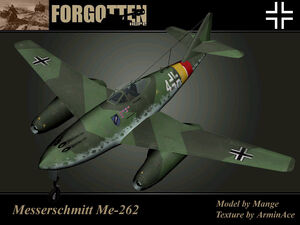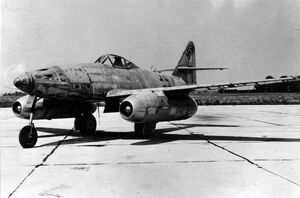The Messerschmitt Me 262 Schwalbe ("Swallow") was the world's first operational jet-powered fighter aircraft. Design work started before World War II began but engine problems prevented the aircraft from attaining operational status with the Luftwaffe until mid-1944. Compared with Allied fighters of its day, including the jet-powered Gloster Meteor, it was much faster and better armed.
One of the most advanced aviation designs in operational use during World War II, the Me 262 was used in a variety of roles, including light bomber, reconnaissance and even experimental night fighter versions. Me 262 pilots claimed a total of 542 Allied kills (although higher claims are sometimes made) against the loss of about 100 Me 262s. The Allies countered its potential effectiveness in the air by relentlessly attacking the aircraft on the ground and while they were taking off or landing. Maintenance problems and a lack of fuel during the deteriorating late-war situation also reduced the effectiveness of the aircraft as a fighting force. In the end, the Me 262 had a negligible impact on the course of the war due to its late introduction and the small numbers that were deployed in operational service.
Me 262 A-1a/U4 "Pulkzerstörer"[]
A unique variant of the Messerschmitt Me-262 was the A-1a/U4 Pulkzerstörer, designed to carry a 50mm Mauser Mk 214 cannon. This was intended to be the ultimate bomber-killer because of the power of that accurate weapon and the pilot's ability of firing outsite the defensive gun range of the American bombers. Of the two airframes converted to this configuration, w/n 170083 (prototype V083) would be evaluated by Watson's Whizzers (54th Air Disarmament Squadron) in US but crashed before that. This particular aircraft, however, became famous by a series of photos in US markings wearing the Willie Jeanne nose art.
Me 262 A-2 "Sturmvogel"[]
The Me-262 A-2 Sturmvogel (Storm Bird) was fitted with two stores pylons under the forward fuselage for two 250 kilogram (550 pound) general-purpose or cluster bombs, and only had the upper pair of MK-108 30 millimeter cannon.
The Sturmvogel was too "clean" for dive-bombing attacks. It would build up too much speed, becoming uncontrollable. It had no bombsight for performing horizontal bombing attacks from medium or high altitudes, but a skilled pilot could use it to perform useful horizontal attacks at low level, particularly with cluster munitions that didn't have to be aimed precisely.
In The first fighting part which has tested Me-262 A-2 in battle, was the squadron of major Wolfgang Shenka generated in July, 1944. Four more divisions of fighters - bombers have been generated on January, 30, 1945, though three of them - I/KG(J)54 , II/KG(J), III/KG(J)6 participated in fights only.
Me 262 B-1a/U1[]
| Me 262 B-1a/U1 | |
|---|---|
| File:Me 262 B-1a.jpg | |
| General Historical Information | |
| Place of origin | Germany |
| Manufacturer | Messerschmitt |
| Speed | 856 km/h |
| Category | Rocket-powered night fighter |
| General Ingame Information | |
| Used by | Germany |
| Guns | 4x 30 mm MK 108 cannon |
| Special abilities | FuG 218 Neptune radar |
| Historical Picture | |

| |
To provide air defence against Allied bomber units 15 training Me 262 were converted to two-seat night fighters equipped with the newly developed FuG 218 Neptune radar system. Top speed 856 km/h. This type flew missions over Berlin air space at the beginning of 1945.
Me 262 C-1a "Heimatschützer"[]
| Me 262 C-1a "Heimatschützer" | |
|---|---|
| File:Heimatschützer.jpg | |
| General Historical Information | |
| Place of origin | Germany |
| Manufacturer | Messerschmitt |
| Speed | 870 km/h |
| Category | Rocket-powered fighter |
| General Ingame Information | |
| Used by | Germany |
| Guns | 4x 30 mm MK 108 cannon |
| Special abilities | Additional acceleration by Walter HWK 109-509 rocket |
| Historical Picture | |

| |
Very early in the development of the Messerschmitt Me.262, meetings between the RLM, Messerschmitt and BMW had proposed alternate power plants for the Me.262. However, the first serious proposals were published in the Project Bureau report of July 22nd 1943.
Three proposed designs were designated the Interceptor I, II and III. However, once work began on the first design in September 1944, it was initially called the Me.262.J1 or Heimatschützer I - "Home Defender I". One of the early series Me.262s Wkr.Nr 130186 had a modified rear fuselage, adapted to carry a redesigned HWK 109-509 motor, with the combustion chamber exhausting at the tail end, beneath a specially cut-away rudder. By the time the first flight had been made, the new model had been given the soubriquet, Me.262.C-1a.
The prototype Me.262.C-1a, "186" was completed, making its first flight on October 16th 1944. But it was not until 27th February 1945 that the first take-off was made with the rocket motor. The take-off run was reduced by at least 200m, and with the turbojets operating, the three minute running of the rocket motor could push the Me.262.C-1a to 26,000 feet.
One recorded interception was made in the rocket-powered "186", when Major Heinz Bar of III./EJG2 took off from Lechfeld. Climbing to nearly 30,000 feet in a little over three minutes he was able to intercept and shoot down a USAF Thunderbolt.
The internal mounting of the HWK motor was problematic in terms of servicing, and severely limited the amount of the J2 fuel which could be carried for the turbo jets. Although there was a limited amount of success with this installation, the Interceptor II and Interceptor III projects were investigated as other important options.
| ||||||||||||||||||||||||||
| |||||














